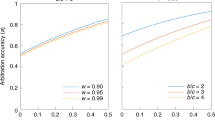Abstract
Brosnan and de Waal1 report that capuchin monkeys show evidence of a sense of fairness or ‘inequity aversion’ because they rejected a less preferred reward when they saw a partner monkey receive a preferred reward for the same task. However, this does not show that monkeys are averse to inequity, only that they reject a lesser reward when better rewards are available. There are risks inherent in seeking anthropomorphic explanations for non-human behaviour.
Similar content being viewed by others
Main
In the ‘inequality test’, the monkeys refused to exchange a token for a cucumber slice (non-preferred reward) on 43% of trials when they saw a partner monkey receive a preferred grape reward for the same effort. However, in the ‘food control’ condition, in which the partner was not present, these same monkeys were just as likely to refuse the cucumber slice when they saw a grape placed where the partner normally sat (49% refusals). There can be nothing inequitous about receiving a non-preferred reward if nobody is receiving anything better. In the food-control condition, the monkeys are refusing the non-preferred reward simply because they can see that a better reward is potentially available. This is therefore the most parsimonious explanation for their refusal to accept the non-preferred reward when they see another monkey receive a better one.
Brosnan and de Waal1 reject this reward-availability explanation for two reasons. First, in a third condition (the ‘effort control’ condition), where monkeys saw their partner receive a grape without having to exchange a token, the monkeys were more likely to refuse the cucumber slice than in the food-control condition. On its own, the comparison of the effort-control and food-control conditions is in the direction required by a fairness account. But fairness cannot account for the equally large difference between the effort-control and inequality-test conditions.
The basis of Brosnan and de Waal's second reason for rejecting the reward-availability explanation is in their Fig. 2, which seems to show an increasing trend of non-exchange for the two conditions in which another monkey was present (inequality test and effort control) and a decreasing trend of rejections in the food-control condition where no other monkey was present. Their Fig. 2 shows mean rejections for the first 10 and last 15 trials (not, as stated in the paper, the first 15 and last 10 trials; Brosnan and de Waal, personal communication) averaged across two sessions.
When the cumulative rate of rejections is represented across all trials of both sessions for Brosnan and de Waal's monkeys, we find that there is no overall increase in rejection rate in the inequality-test and effort-control conditions, and that the rate does not decline across sessions in the food-control condition (results not shown).
Although explanations of animal behaviour in anthropomorphic terms are notoriously prone to imprecision2, if ‘fairness’ or ‘inequity aversion’ mean anything in this context, they surely imply that individuals reject rewards more often when they see another receive a better reward than when the better reward is simply in view with no one else there to consume it. The very similar levels and patterns of cucumber rejection in the inequality-test and food-control conditions therefore contradict an account based on fairness or inequality.
References
Brosnan, S. F. & de Waal, F. B. M. Nature 425, 297–299 (2003).
Wynne, C. D. L. Do Animals Think? (Princeton Univ. Press, in the press).
Author information
Authors and Affiliations
Corresponding author
Rights and permissions
About this article
Cite this article
Wynne, C. Fair refusal by capuchin monkeys. Nature 428, 140 (2004). https://doi.org/10.1038/428140a
Issue Date:
DOI: https://doi.org/10.1038/428140a
Comments
By submitting a comment you agree to abide by our Terms and Community Guidelines. If you find something abusive or that does not comply with our terms or guidelines please flag it as inappropriate.



